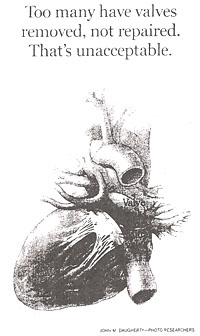
The Mitral Valve Question
By Bernadine Healy, M.D.
Posted September 28, 2007
Source:
U.S. News & World Report
 Replace or repair, that's the question. And it is the single most critical one for patients facing cardiac valve surgery. The 2007 Lasker Award for medical research highlighted the distinction, perhaps inadvertently, when it honored two heart surgeons last month for developing artificial heart valves. Albert Starr of Portland, Ore., devised mechanical replacements using metal cages and silicone balls, and Alain Carpentier of Paris fashioned bioprostheses from tanned pig valves sewn onto metal rings. The irony is that Carpentier went on to find a way not to replace the leaky mitral valve. Surgical reconstruction spares the natural valve, and the outcome is vastly better. Unfortunately, thousands of patients suitable for repair are still having their valves removed, missing out on what might be Carpentier's greater contribution—particularly if you have a mitral problem.
Replace or repair, that's the question. And it is the single most critical one for patients facing cardiac valve surgery. The 2007 Lasker Award for medical research highlighted the distinction, perhaps inadvertently, when it honored two heart surgeons last month for developing artificial heart valves. Albert Starr of Portland, Ore., devised mechanical replacements using metal cages and silicone balls, and Alain Carpentier of Paris fashioned bioprostheses from tanned pig valves sewn onto metal rings. The irony is that Carpentier went on to find a way not to replace the leaky mitral valve. Surgical reconstruction spares the natural valve, and the outcome is vastly better. Unfortunately, thousands of patients suitable for repair are still having their valves removed, missing out on what might be Carpentier's greater contribution—particularly if you have a mitral problem.
An estimated 40,000 patients a year, many under 50, have operations for leaky mitral valves, caused most often by a degeneration of one or both of the delicate, pearly white mitral leaflets hinged to the base of the heart. The leaflets protrude into the left ventricle—the most important of the heart's chambers—where they are anchored by a bevy of chords to its inside wall. When leaflet tissue becomes thick and spongy, sometimes encrusted with calcium, and the chords stretch or even snap, the valve can't close properly and leaks. With a hefty leak, the heart pumps more and more blood to keep up, enlarging to compensate, and, in time, it will fail.
 For years, the only choice was replacement with off-the-shelf artificial valves. But mechanical valves require lifelong blood thinners to prevent clot formation, and many tissue valves—from pigs or even cadavers—give out in 10 to 12 years, requiring another, riskier, operation.
For years, the only choice was replacement with off-the-shelf artificial valves. But mechanical valves require lifelong blood thinners to prevent clot formation, and many tissue valves—from pigs or even cadavers—give out in 10 to 12 years, requiring another, riskier, operation.
Repairing the natural valve circumvents these problems, but the procedure is often longer and calls for special expertise plus a heavy dose of judgment during surgery. In essence, it's valve plastic surgery: nipping and tucking redundant leaflet tissue, removing segments that balloon into the valve orifice, chipping calcium away, shoring up or removing overstretched chords, and placing a stabilizing ring around the repair. The fixed valve looks young again, and its function is restored to normal—or pretty close.
This technique is hardly off-the-shelf. Most surgeons perform only a handful of mitral operations each year, predominantly replacements. Repair expertise, particularly needed for tough cases, is concentrated in high-volume heart centers. This often means distant referral, which is a less convenient option for patients who will inevitably ask, "Is it worth it?"
Unequivocally, yes. Compared with replacement, repair brings better heart function and less risk of infection, blood clots, and stroke. Patients live longer, too. Just last week, the Europeans issued formal practice guidelines for valve surgery, similar to ones issued here in 2006, clearly stating that repair is preferable to replacement in all patients with severe mitral leaks. And in the right hands, more than 90 percent of valve leaks can be successfully repaired.
Missing out. The actual number getting repair is closer to 50 percent, and that's unacceptable, says David Adams, head of heart surgery at the Mount Sinai Medical Center in New York. "Too many miss out on optimal surgical treatment," he says. But this is fixable. Surgeons who offer patients only valve replacement because that's what they do well must think again. So must cardiologists reluctant to refer patients elsewhere for care. And insurance providers, who make doctors and patients jump through hoops for treatments outside of their networks, can't fight clear-cut practice guidelines.
Fourteen years ago, a young man who worked for me confided that he had a loud heart murmur. Sure enough, he had a leaky mitral valve. With my cardiologist hat on, I told him never to forget one piece of advice: Someday he would likely need an operation, and wherever he was, whoever his doctor was, he must go to a place skilled at repair. Ten years later, he called. His heart was enlarging, and his doctor felt he needed surgery: Did I still think he should have a repair and not a replacement? My answer was the same—and his own valve is now working just fine.
The answer may not be the same for everyone, but far too many patients are simply not asking his question—and too many others are, but getting the wrong answer.
|
